Sincelejo
Sincelejo (Spanish pronunciation: [sinseˈlexo]) is the capital and largest city in the Colombian department of Sucre. It is also the main city in the denominated Región Sabanas (Savannas Region), a subdivision of the Caribbean Region of Colombia, and the 23rd largest city by population in Colombia.[2] It is located 30 kilometers from the Caribbean Sea by the Gulf of Morrosquillo, 125 kilometers from Cartagena, and 200 kilometers from Barranquilla.
Sincelejo | |
|---|---|
Municipality and town | |
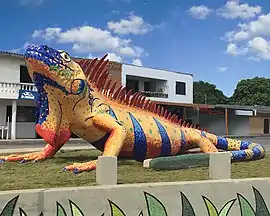 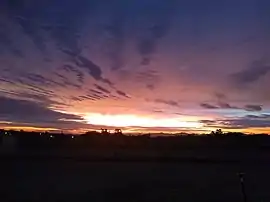 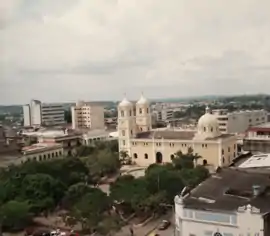 | |
 Flag 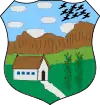 Coat of arms | |
| Nickname(s): La Perla de la Sabana / La Ciudad del Encuentro | |
| Motto(s): "Más Soluciones, Más Compromiso" (More Solutions, More Commitment) | |
 Location of the municipality and city of Sincelejo in the Department of Sucre | |
 Sincelejo Location of the municipality and city of Sincelejo in the Department of Sucre | |
| Coordinates: 9°17′42″N 75°23′46″W | |
| Country | |
| Region | Caribbean Region |
| Department | Sucre |
| Established | October 4, 1535 |
| Founded by | Antonio de la Torre y Miranda |
| Government | |
| • Type | Municipality |
| • Mayor | Jacobo Quessep Espinosa |
| Area | |
| • Municipality and town | 278.4 km2 (107.5 sq mi) |
| • Urban | 18.9 km2 (7.3 sq mi) |
| Highest elevation | 240 m (790 ft) |
| Lowest elevation | 180 m (590 ft) |
| Population (2018[1]) | |
| • Municipality and town | 277,773 |
| • Density | 1,000/km2 (2,600/sq mi) |
| Demonym(s) | Sincelejano |
| Time zone | UTC-5 (EST) |
| Area code(s) | 57 + 5 |
| Website | Official website (in Spanish) |
History
The land comprising Sincelejo was inhabited in the Prehispanic age by several groups of indigenous people known as the Zenú.
Sincelejo was founded on October 4, 1535, the feast day of Francis of Assisi, with the name San Francisco de Asís de Sincelejo. The village used to be a part of Alonso Padilla's encomienda between 1610 and 1640, and was located on the site of a small Zenú indigenous settlement. At that time the indigenous people were overpowered and exploited by the Spanish colonizers, or encomenderos.
On November 21, 1775, Sincelejo was re-founded by the Spanish captain and engineer, Antonio de la Torre y Miranda, following orders from Cartagena's governor, Juan de Torrezar Díaz Pimienta. The construction of the town began with a church, the lands around the church given to people who used to live across the region; this was to create a religious and political center in the zone. Sincelejo was intended to follow the classical Spanish colonial grid, with the main church and its square in the center of the town, but this was not possible because of several creeks that ran through the town.
In 1812, Sincelejo became shelter for the revolutionary priests in La Rebelión de los Curas (the Priests' Insurrection).
By 1887, Sincelejo was one of the leading towns in the Province of Cartagena. In 1908 it became the short-lived capital of the department of Sincelejo, ultimately becoming part of the Province of Cartagena again in 1910. In 1912, Sincelejo almost disappeared because of a massive conflagration which destroyed most of the central zone; nevertheless the town was rebuilt. With the creation of the Sucre Department in 1966, Sincelejo subsequently became the capital.
On January 20, 1980, the Corralejas Stadium collapsed, killing at least 200 people.[3]
Geography
The geography of Sincelejo is typical of mountain scenery, consisting of irregularly-shaped surfaces with variable slope and altitudes ranging from 50 to 260 meters. The weather is warm and dry, with average annual rainfall of 500–1200 mm.
The hilly landscape is the most defining feature of the town, extending from the mountains to the borders of the plateau in the north and south. Erosion is present in the rugged topography of rolling hills, which are moderately to strongly broken, with slopes between 7-50%.
The small mountain foothills in the municipality span from the marine fluvial plain in the west to the border shared with the town of Palmito. The terrain varies from flat to inclined.
Boundaries of the city
Sincelejo is bordered by the municipalities of Palmito and Tolú to the west, Sampués and Córdoba Department to the south, Corozal and Morroa to the east and Toluviejo to the north.
Climate
Sincelejo is in the tropics, so its temperatures remain fairly consistent throughout the year, with an average temperature of about 27 °C ( 80.6° F). It has a tropical wet and dry climate (Aw) according to the Köppen climate classification.
The Drought season usually starts in the first or second half of December and extends until the end of February to the first half of March. The rainy season starts sporadically and gradually increases, peaking in April or May. In June and July, precipitation decreases (in a period called "Veranillo de San Juan") until it increases once more.
| Climate data for Sincelejo | |||||||||||||
|---|---|---|---|---|---|---|---|---|---|---|---|---|---|
| Month | Jan | Feb | Mar | Apr | May | Jun | Jul | Aug | Sep | Oct | Nov | Dec | Year |
| Average high °C (°F) | 32.7 (90.9) |
32.8 (91.0) |
33.4 (92.1) |
32.9 (91.2) |
31.6 (88.9) |
31.1 (88.0) |
31.9 (89.4) |
31.5 (88.7) |
30.8 (87.4) |
30.5 (86.9) |
30.6 (87.1) |
31.5 (88.7) |
31.8 (89.2) |
| Daily mean °C (°F) | 26.4 (79.5) |
26.8 (80.2) |
27.5 (81.5) |
27.5 (81.5) |
27.0 (80.6) |
26.6 (79.9) |
26.7 (80.1) |
26.5 (79.7) |
26.2 (79.2) |
25.9 (78.6) |
26.0 (78.8) |
26.1 (79.0) |
26.6 (79.9) |
| Average low °C (°F) | 20.1 (68.2) |
20.9 (69.6) |
21.6 (70.9) |
22.2 (72.0) |
22.4 (72.3) |
22.1 (71.8) |
21.6 (70.9) |
21.6 (70.9) |
21.6 (70.9) |
21.4 (70.5) |
21.4 (70.5) |
20.7 (69.3) |
21.5 (70.6) |
| Average rainfall mm (inches) | 20.4 (0.80) |
23.1 (0.91) |
21.8 (0.86) |
119.0 (4.69) |
180.0 (7.09) |
145.4 (5.72) |
124.3 (4.89) |
157.6 (6.20) |
170.2 (6.70) |
164.0 (6.46) |
103.9 (4.09) |
58.6 (2.31) |
1,288.3 (50.72) |
| Average rainy days | 3 | 3 | 4 | 9 | 14 | 12 | 11 | 15 | 14 | 13 | 10 | 5 | 113 |
| Average relative humidity (%) | 77 | 76 | 76 | 78 | 82 | 83 | 81 | 83 | 84 | 84 | 83 | 79 | 81 |
| Mean monthly sunshine hours | 234.2 | 211.8 | 199.1 | 156.8 | 141.2 | 167.1 | 199.9 | 188.4 | 144.7 | 155.7 | 164.2 | 217.0 | 2,180.1 |
| Source 1: [4] | |||||||||||||
| Source 2: [5][6] | |||||||||||||
Administrative divisions
Sincelejo is subdivided into an urban zone and a rural zone. The urban zone is divided into 9 Comunas (townships), while the rural has 21 divisions named Corregimientos.[7]
Urban Division[8]
| La Selva Villa Orieta |
San Carlos Kennedy |
Pioneros Argelia |
Majagual El Zumbado |
La Palma La Ford |
La Vega La Fé |
Margaritas Florencia |
Uribe Gran Colombia |
Verbel El Progreso |
Rural Division[8]
| San Rafael La Arena La Chivera Las Majaguas La Peñata |
Las Huertas Laguna Flor Cerrito de la Palma Cruz del Beque San Antonio |
Buenavista Buenavistica San Martín San Jacinto Cerro del Naranjo Babilonia Sabanas del Potreto La Gallera |
Las Palmas Castañeda Chochó |
Demographics
In 2018, Sincelejo had a population of 277,773.[9] 83.7% of residential buildings are houses, while 12.1% are apartments; 98.1% of the housing has regular electricity; 83.7%, is connected to a sewage system; 79.7%, has a regular water supply; 79%, has natural gas and 50% has telephones. In Sincelejo, 51.6% of the residents are women, while 48.4% are men. The literacy rate is 87.5%. 11.5% of the citizens of Sincelejo recognize themselves as indigenous people, 3.4% as African-Colombians, and 85.1% recognize themselves as mestizos (mixed-race).[10]
| Year | Pop. | ±% |
|---|---|---|
| 1775 | 2,855 | — |
| 1852 | 6,046 | +111.8% |
| 1870 | 11,336 | +87.5% |
| 1918 | 14,722 | +29.9% |
| 1951 | 21,625 | +46.9% |
| 1964 | 44,001 | +103.5% |
| 1973 | 71,946 | +63.5% |
| 1985 | 120,537 | +67.5% |
| 1993 | 168,410 | +39.7% |
| 2005 | 237,639 | +41.1% |
| 2018 | 277,773 | +16.9% |
| Source: DANE | ||
Economy
The main economic activities of the municipality of Sincelejo revolve around the area and neighboring department specifically in the livestock sector, agriculture, commerce, and other services. Because of the excellent quality, and breeding of is cattle, Sincelejo has been called the Capital Cebuísta de Colombia. It has facilities for fattening herds. Dairy farming is done on a smaller scale but is an important contributor to the city's economy.
Agriculture, is secondary to livestock farming, and is highlighted by the production of maize, cassava, yams, and bananas. Trade and other services, especially the government, are important economic activities in Sincelejo, supplementing the primary activities of the agricultural sector.
Industry is beginning to grow in the city with its new factories, including Postobón stands (drink stand), almidón (starch production), clothing, footwear, icopor (styrofoam), metal equipment, bricks, concrete, construction materials, and wood processing in particular, highlight the microenterprises in the municipality.
The economy of Sincelejo is sustained is sustained by: trade and services offered by banks, chain stores, clinics, restaurants, service stations, fixed and mobile telecommunications, road and air transport, automobiles, workshops. According to a recent census of the Industry and Commerce department, there are about 3000 establishments of all kinds of operating in the capital.
Culture
The traditional music of Sincelejo includes porro and fandango (similar to samba in Brazil). The typical dish of this city is mote de queso which is a soup with cheese. The city is known for its hamacas (hammocks) and the sombrero vueltiao (turned hat), which are both made by the native inhabitants. The sombrero vueltiao is also as a national symbol of Colombia. The city is also the seat of the Roman Catholic Diocese of Sincelejo.
Every January, Sincelejo opens the holiday for Fiestas del dulce nombre de Jesús (The party of the sweet name of Jesus) which takes place on January 20. The festival begins a few days earlier and includes a number of parades, a beauty contest, and several days of bullfighting within a temporary wooden circular structure similar to a stadium named Corraleja. This is why the holiday is also called Las Fiestas de Corraleja. On January 20, 1980, a combination of overcrowding and panic caused the bullring's wooden bleachers to collapse, killing 222 persons, although some estimates place the death toll at almost 400.[3] This tragedy put traditional Corraleja on hiatus. In 1999 the municipality authorized the construction of the wooden structure renewing the bullfighting.
The Encuentro Nacional de Bandas (National Meeting of the Bands) also takes place in Sincelejo. This is a musical contest where folk bands perform the traditional musical styles of the Savanna Region: Porro and Fandango. The contest began in 1984 and takes place in the mid-year and it awards creativity and performance.
Another cultural yearly event in Sincelejo is Festival Sabanero del Accordeón (Savanna's Accordion Festival). Unlike the National Meeting of Bands, this festival is about the folk musical styles played on the accordion and it includes four styles: Paseo, Merengue, Son and Puya. The first winner of this contest was Lisandro Meza in 1974.[11] The festival was created to show the Savanna's culture to the country and to the world. There is always some controversy when the styles of Valledupar, specially the paseo, win.
Sincelejo has several institutions devoted to cultural work such as La Escuela de Bellas Artes (School of Fine Art), Batuta among others.
Sites of interest
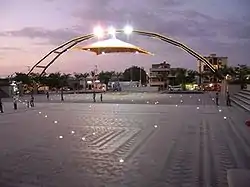
Majagual Plaza: Usually called La Placita de Majagual (The Little Plaza of Majagual), it has been referred to in several folk songs by artists such as Joe Arroyo. This plaza was the epicenter of the January 20 Corralejas for many years before it moved to La Plaza de Mochila where it took place until the disaster of 1980. Since then, Majagual Plaza was only used for activities related to sport., In 2007 it was relaunched with a new concept and post-modern design with an arch-shaped sculpture and a wide square for cultural events.
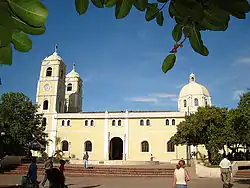 Santander Park and Saint Francis of Assis Cathedral |
Santander Park and Saint Francis of Assis Cathedral: As old as Sincelejo, the Santander Park was opened in 1776 and it was the first place where the January 20 Corralejas took place in 1845 running until 1964 when it was moved to Majagual Plaza. Just next to the park is the Catedral San Francisco de Asís (Saint Francis of Assis Cathedral), which was established in 1853. It is the center of the religious celebrations that take place throughout the year in Sincelejo such as: Easter, Virgin Mary, Sacred Heart and the most important celebration that takes place on January 20 - Las Fiestas del Dulce Nombre de Jesús (The party of the sweet name of Jesus).[12]
Sincelejo's Municipality Theater: It was established in 1997 and it is a beautiful facility where concerts, musicals, folk events and theater operas take place. It is the cultural facility for excellence in Sincelejo.
VIVA Sincelejo Shopping Center: The VIVA Sincelejo Shopping Center (Centro Comercial VIVA Sincelejo) was opened in August 2006, as Saint Francisco Shopping Center (Centro Comercial San Francisco). It had a play ground for children, four movie theaters, and shops. It was located on Las Peñitas Avenue (Avenida Las Peñitas), the investment was about ten thousand million pesos.
In 2011 construction of a new mall in the same place began. The VIVA Sincelejo Shopping Center will have 91 shops where it is possible to find clothes, shoes, food and entertainment. The mall's area is about 31,000 square meters including parking space for 453 cars and 201 motorcycles. The very first stage of the mall was inaugurated in May 2013, the second one in August, and the third one in November. The total investment for this facility is twenty-five thousand million pesos (About 12.5 Million US Dollars). This mall holds the biggest shopping center in Sincelejo: Almacenes Exito.[13]
Corraleja

Sincelejo is best known for its yearly folkloric and religious party - the 20th of January Party Fiestas del dulce nombre de Jesús (The party of the sweet name of Jesus) also known as Jesus' Sweet Name Party. This party includes a structure known as Corraleja, which is a temporary crafty wooden bullring, where the main attraction is watching the bullfighters facing the bulls. There is no official remuneration for the bullfighters who dare to enter the ring, but usually the wealthiest landowners state an unofficial monetary incentive for those who stab the bull using small prickers. The picadors are also a part of the show, but they belong to cattle raising farms and they're paid for their work, but the unofficial incentive also applies for them.
The construction of the temporary bullring starts at the end of December, and civil engineers and architects supervise the work of dozens of workers. The bullfighting takes places in four or five journeys (a journey a day), usually including the weekend. Different cattle rising farms (previously chosen) are in charge of supplying the bulls - about 40 bulls per day - so at the end of the last day the most entertaining journey is chosen, with people's participation, and the cattle rising farm is awarded with an official incentive. A ticket to watch a bullfighting journey costs about 15-35 US Dollars and usually the last journey is the most expensive.
The main criticisms of the corraleja is the treatment of the animals, not only in the bullfighting but as it is being prepared, the safety of the usually unskilled bullfighters, and the consumption of alcohol within the bullring by watchers and bullfighters. Anyone who dares to join the bullfighters must have insurance, which is sold on site, so if they are hurt their medical costs are covered.
Media
Two local dailies circulate in Sincelejo: El Meridiano de Sucre and El Universal Sincelejo. There are also regional and national newspapers such as: El Tiempo, El Espectador and El Heraldo.
There are several radio stations. On the A.M. band there are Radio Caracolí, Radio Piragüa, Radio Chacury, Radio Sabanas, Radio Sincelejo, Ecos de la Sierra Flor and local stations of RCN Radio and Caracol Radio. On F.M. there are: Olimpica Stereo, Tropicana Stereo, Primavera Stereo, Bésame, 94.3 F.M., Marina Stereo and Unisucre FM Stereo, and Radio Tiempos.
Sincelejo receives five national television channels: RCN, Caracol, Canal Uno, Señal Colombia and Señal Institucional. There are two cable TV services: Claro and Cable Unión. Claro has the only local TV channel named Canal Doce (Channel 12) which is available for its subscribers. It includes several programs as well as a newscast devoted to Sincelejo and its zone of influence.
Transportation
Sincelejo is known for being an important crossroads on the Colombian Caribbean coast. It is placed close to several important towns in the region - Montería, Magangué, Coveñas and San Marcos - and it is also relatively close to important cities in Colombia like Barranquilla, Cartagena, Valledupar and Medellín. There is regular transportation from Sincelejo to these cities by bus and taxi, with taxis being a little more expensive.
15 kilometers away from Sincelejo is Las Brujas Airport where there are daily flights to the major cities of Bogotá and Medellín.
Education
As the main city in Sucre and the Savannas Región, Sincelejo has a large number of students, with 35 public schools and several private schools. Also, there are several universities: Universidad de Sucre, which is the only public university in Sincelejo and Sucre. There are several private universities: CECAR, CORPOSUCRE, CUN, Universidad San Martín, Universidad Santo Tomás, Remington and there is a local office of the Universidad de Pamplona. There are several institutions offering technical and technological training the most important being the local facility of SENA.
Notable residents
- Jorge Alfaro, Major League baseball player
- Ariadna Gutierrez, Model and Beauty Pageant Titleholder
External links
References
- https://www.dane.gov.co/files/varios/informacion-capital-DANE-2019.pdf
- http://www.dane.gov.co Censo 2005 Dane
- "Bullfight spectators die when bleachers collapse". history.com. A&E Television Networks, LLC. Retrieved January 12, 2017.
- "Data". www.ideam.gov.co. Retrieved 2020-07-04.
- https://climate-data.org/south-america/colombia/sucre/sincelejo-3540/
- http://bart.ideam.gov.co/cliciu/corozal/tabla.htm
- Plan de Ordenamiento Territorial de Sincelejo 2004–2007
- Sincelejo, Knol http://knol.google.com/k/carlos-mario-castro-navarro/sincelejo-colombia/1i29ptfum49sf/18#%5B%5D
- https://www.dane.gov.co/files/varios/informacion-capital-DANE-2019.pdf
- http://www.dane.gov.co Boletin Perfil Sincelejo
- Sabanero, "Archived copy". Archived from the original on 2008-08-04. Retrieved 2008-08-30.CS1 maint: archived copy as title (link)
- Cultura Colombiana Sinic
- http://www.exito.com/AmpliarPublicacion.aspx?id=572 Centro Comercial San Francisco
